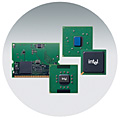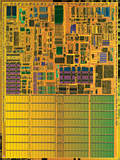Intel Launches Intel® Centrino™ Mobile TechnologyNew Capabilities Unwire Mobile PCs to Change Where and How People Compute and CommunicateSANTA CLARA, Calif., March 12, 2003 - Intel Corporation today introduced Intel® Centrino™ mobile technology, integrating wireless capability into a new generation of mobile PCs that will bring business users and consumers greater freedom to connect in new places and in new ways. Representing Intel's best technology for mobile PCs, Intel Centrino mobile technology includes a new mobile processor, related chipsets and 802.11 wireless network functions that have been optimized, tested and validated to work together. In addition to wireless communications, Intel Centrino mobile technology includes features designed to enable extended battery life, thinner and lighter notebook designs, and outstanding mobile performance. "Unwiring the PC will change the way people use computers, allowing them to communicate, be productive or be entertained wherever and whenever they want," said Craig Barrett, Intel's chief executive officer. "Our focus on integrating all the elements of mobility allows Intel Centrino mobile technology to deliver an outstanding wireless computing experience and marks the first time we've put a combination of technologies under a single brand. This breakthrough innovation, together with industry-wide investment and Wi-Fi hotspot deployments, brings new computing and communications capabilities to businesses and consumers, adding value to mobile PCs." Intel Centrino mobile technology-based notebook PCs are available immediately from leading computer makers worldwide. System pricing will start as low as $1,399, comparable to today's mainstream notebooks. Computer shoppers can identify these notebooks by a Centrino brand logo featuring a striking magenta color and the Intel Inside® mark. Accelerating "Hotspot" Deployment Worldwide Using truly mobile notebook computers can change the way people live. With notebooks based on Intel Centrino mobile technology, a business traveler can check office email or read the hometown newspaper online while waiting for a flight at the airport, and still have battery life left to watch a DVD movie on the plane ride home. A real estate agent can check the latest listings wirelessly while dining with prospective home-buyers. A financial planner can check the market and activate client orders while at a seminar without compromising on the performance necessary to run the most demanding office applications. Students can register for next semester's classes or seek a part-time job from the college library, all on a sleek, light-weight system that won't drag them down. As part of the introduction of Intel Centrino mobile technology, Intel has been working with leading wireless network service providers, hotels, airports, retail and restaurant chains worldwide to accelerate deployment and increase awareness of wireless public hotspots. In addition to marketing and promotional activities, Intel developed the Wireless Verification Program which includes engineering and testing of Intel Centrino mobile technology with various access point devices, software combinations, hotspot locations and wireless service providers to verify they are compatible, further enhancing the end user's wireless experience. Intel's efforts worldwide have already resulted in thousands of verified hotspots. The company expects to verify more than 10,000 by the end of the year. Intel has also created a standardized worldwide Wireless Identifier Program that includes signs to help users identify where they can connect wirelessly. The program informs users that a particular service provider's network has been verified with Intel Centrino mobile technology. In addition, the company last year created a $150 million fund to invest in companies that are helping to expand and accelerate the infrastructure and capabilities required to make wireless computing ubiquitous. The Technology Inside The processor is based on a new mobile-optimized microarchitecture that delivers higher performance and lower power consumption to enable longer battery life in today's mainstream systems. Key features include: Micro-Ops Fusion, which combines two micro-operations into one, enabling it to execute faster and at lower power; Advanced Branch Prediction -- a new implementation technique -- to help to reduce overall latency in the system contributing to higher performance at lower power; and the Dedicated Stack Manager, which reduces the overall number of micro-operations required to generate higher performance at lower power. The processor is manufactured using Intel's industry-leading 0.13-micron process technology and consists of 77 million transistors. It also includes a 400 MHz power optimized system bus, a 1 MB low-power L2 cache (which turns off parts of the high-speed memory when it's not needed), and technology to reduce overall platform power consumption. It also provides support for Enhanced Intel® SpeedStep® technology with multiple voltage and frequency operating points, and Streaming SIMD Extensions II. The Intel 855 chipset family includes two new chipsets developed exclusively for the mobile market segment, the 855PM supporting discrete graphics and 855GM with integrated Intel® Extreme Graphics 2 technology. The new chipsets also support Enhanced Intel SpeedStep technology, Deeper Sleep Alert State and an internal timer that automatically turns off the chipset clock when the chipset is inactive. The 855GM chipset also includes a low-power graphics power management mode. Both chipsets include a 400MHz processor system bus and support for up to 2GB of DDR 266 memory, along with support for USB 2.0 and Intel's I/O Hub Architecture. The Intel PRO/Wireless 2100 Network Connection has been designed and validated to connect easily to 802.11b Wi-Fi certified access points. It also supports advanced wireless LAN security including 802.1x, WEP and VPN technologies, and will be software upgradeable to support WPA. In addition, through strategic collaboration with Cisco Systems, Intel Centrino mobile technology will support Cisco* LEAP and will be software upgradeable to Cisco* Compatible Extensions. The Intel PRO/Wireless 2100 network connection has also been verified with leading VPN (virtual private network) suppliers. The wireless card is also available with Intel® PROSet Software, which offers many ease-of-use and low power features. It also supports an Intel developed technology that reduces interference with 802.11 signals and certain Bluetooth™ devices. Measuring Mobile Performance And Battery Life In addition, users of Intel Centrino mobile technology based-systems will find 59 percent better performance in their Internet experience as measured by the WebMark* benchmark when compared to the mobile Intel PentiumIII processor-M 1.2GHz and a 13 percent improvement gain when compared to the mobile Intel Pentium 4 processor-M 2.4GHz. Product Pricing These prices represent the cost of each component (processor, chipset, WLAN) that together make up Intel's Centrino mobile technology. Intel also sells each device separately. Intel, Intel Centrino, Pentium, SpeedStep technology are trademarks or registered trademarks of Intel Corporation or its subsidiaries in the United States and other countries. Other names and brands may be claimed as the property of others. Other marks and brands may be claimed as the property of others. *For more information on Intel's mobile performance, visit: www.intel.com/performance |
|
Virtual press kit
|
The launch of Intel’s Centrino in 2003 marks move that took laptop PCs into the mobile world. At the time, PCs were still desk anchors chained to a wall socket. But these anchors had shrunk from big beige boxes to notebooks that people carried around. The old paradigm had not pivoted enough to reveal a problem. The world had adjusted with conference room tables that had ditches in their center, which contained access to ethernet and power. Back then, a light notebook could be described as weighing five pounds with a two-pound power-brick. Yet, this was a cutting-edge improvement over the previous generation of “luggables” made famous by Compaq Computer. The question was, what really lay in the future?
Intel had developed a strategy based on “The Four Vectors of Mobility: Performance, Battery Life, Form Factor, and Connectivity.” Of the four, only one was severely lacking: Connectivity. What connectivity there was meant connecting wires to a phone or ethernet jack. Connecting to a cell phone was virtually impossible. Seen this way, you can see why WiFi was such an obvious technical choice. But it wasn’t that simple. Nor was the problem technical. They couldn’t just sell chips. They had to ignite an infrastructure of WiFi hot spots in the wild for connectivity to be real. They would start with airports, then bus and train terminals, and then with Starbucks. By the time they hit Starbucks, customers were coming for the hot spot as much as for the coffee, which took WiFi viral. Once WiFi was driving customer choice about where to get their coffee, every coffee shop and then other retailers had to get on board.
It is often claimed that Intel was a failure in mobile. But those that make this claim limit the term ‘mobile’ to smart phones, ignoring the role of WiFi. WiFi has always been the neglected sibling of cellular. But before you consider it a failure, consider that Intel’s profits of $11B in Otellini’s last full year was over 60% higher than the total of Broadcom’s and Qualcomm’s that year. It’s true that Intel never credibly made it across the bridge to cellular in the public’s eye. But one should not neglect the fact that no one had to create a wireless infrastructure in cellular for the smartphone. It was already there to be taken advantage of. No such infrastructure existed for WiFi, for which the creation of by Intel was a far more monumental task. Imagine what your life would be like if it had not been done. The buildout of the WiFi infrastructure didn’t involve following the simple cadence of technology. Making WiFi real had to be approached by creating new emergent behavior in the world outside technology to make it successful.



